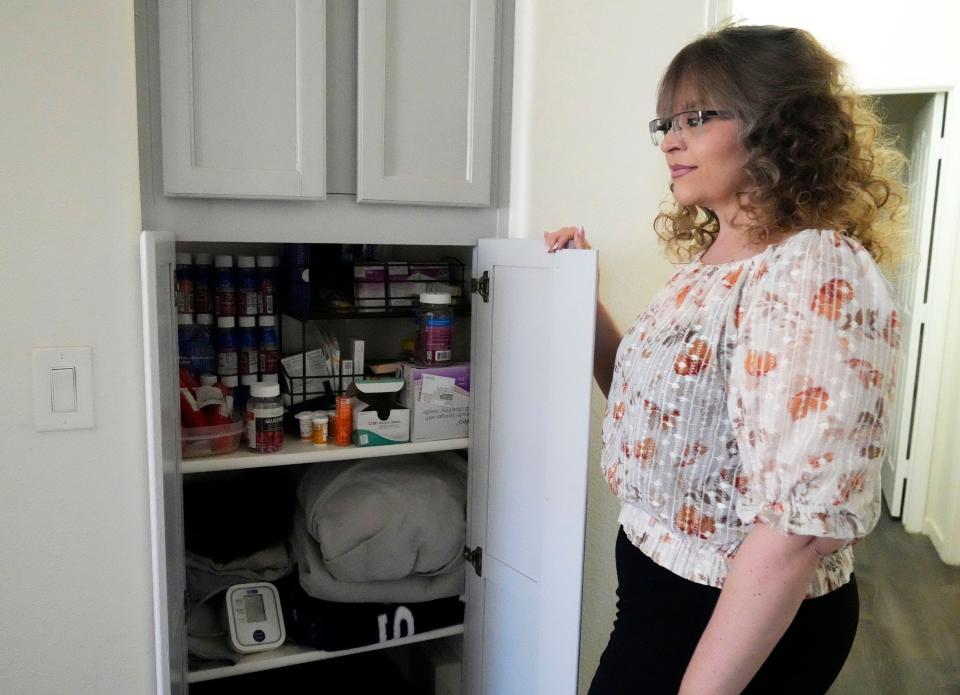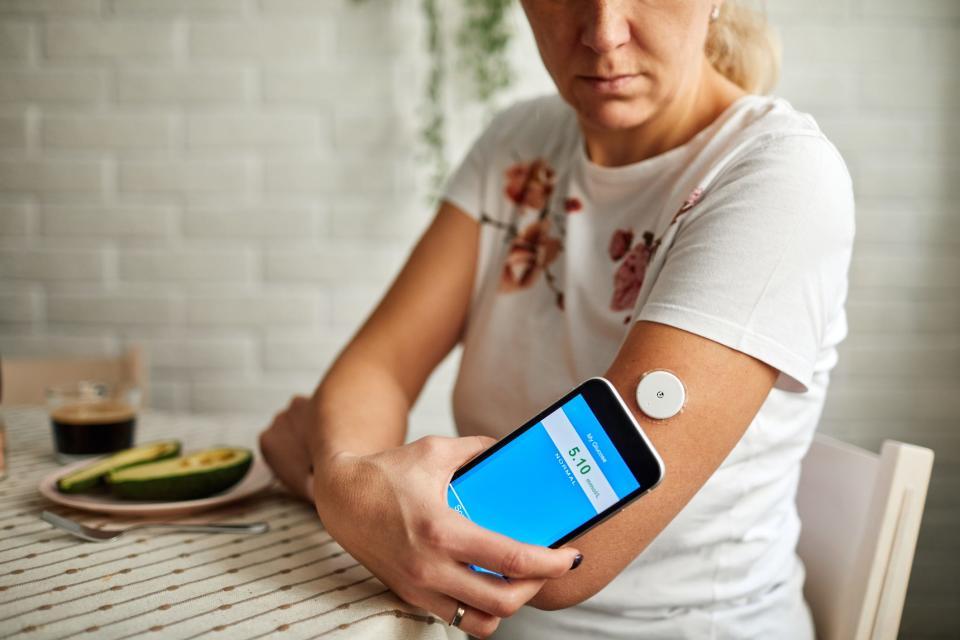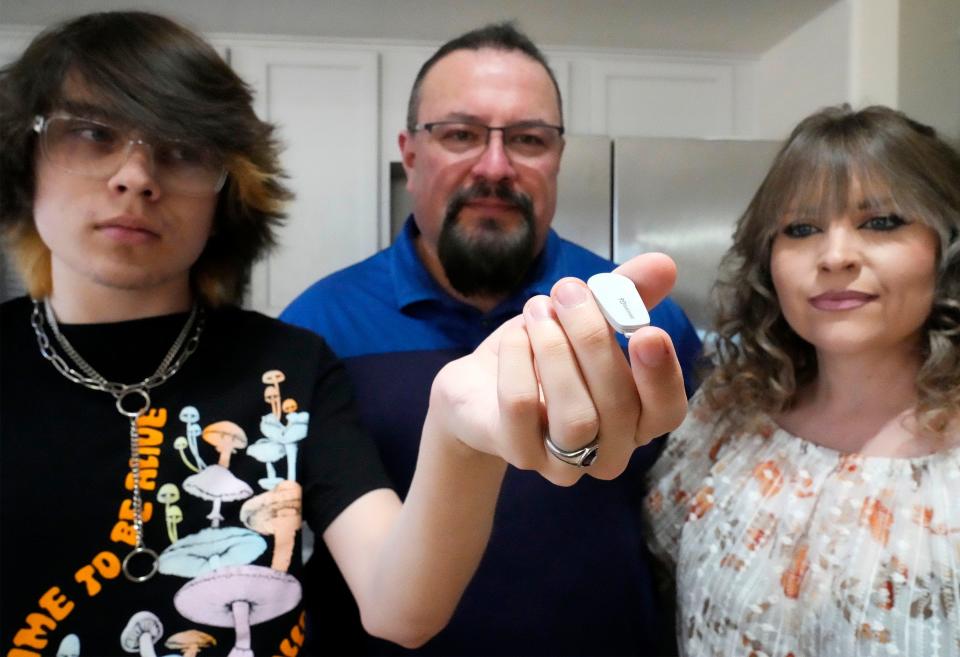A tiny device can help diabetics live with their disease, but getting one can be an ordeal

Summer Huerta was in the car with her family when she realized there was something wrong with her eyes.
Her husband, Ernesto, had pointed out a formation of birds. Her son, Leo, saw them too. But all Summer could see was a blurry patch of sky.
“I could not see one bird,” she said. “And that started to make me have this panic from the inside.”
Summer kept wiping her glasses, but her vision didn’t improve. She felt dizzy. When she returned home to Sierra Vista, she went straight to her eye doctor, even though she’d just gotten a new prescription. When he asked her which letters she could read on the chart, she said she couldn’t read any of them.
The eye doctor got up and gave her a hug. Then he sent her to urgent care.
There, the nurse pricked Summer’s finger to measure her blood glucose. She says the nurse told her that her number was 241 — a very high reading.
“I didn’t know at all what that meant,” Summer said. But soon, she would. Because that day, about 5 years ago, she was diagnosed with Type 2 diabetes.
Type 2 is one form of a disease that can make measuring blood glucose levels a matter of life or death — and while there are technologies that can make a big difference in managing the disease, that day in urgent care, Summer was still a long way from accessing them.
Even today, that technology still isn’t always within reach for Summer. But when all this started, she had no idea of the journey that was in store for her.
Some of it had to do with medications and medical charts and hospital bills. But a lot of it had to do with a small biomedical device called a continuous glucose monitor, or CGM.
A CGM is a device that measures blood sugar, and it's already begun to revolutionize diabetes care. But many patients run into barriers to access. Insurance criteria, racial and cultural hurdles and supply issues give CGMs a prohibitive price tag as well as an emotional toll.
And that's just half the story. The wellness industry is now starting to market the devices to people who don't have diabetes at all, people who use the monitors in physical fitness or wellness regimens.
But Summer didn't know any of that as she waited in urgent care.
A trip to the hospital, a turn for the worse
The doctors sent her home with medications, which should have worked for a Type 2 diagnosis. Instead, Summer got sick again.
The medications “would make me feel like I got punched in my stomach,” she said. The doctors had also instructed her to lose weight, so even though she felt near-constant fatigue, heartburn-like symptoms and muscle aches, she dutifully went to the gym every morning.
Though she had always considered herself an active person and spent long hours doing physical tasks at work, she struggled with even basic movements. Exercise was “just really, really, really hard. I (thought) it was going to snap my muscles,” she said.

Summer’s feet hurt. Her fingers hurt. Her scalp, right where the hair came out of her head, hurt. At her retail job, she found herself unable to walk from department to department. She would take 10 steps, then stop to catch her breath. Another 10 steps. Out of breath.
“I was leaning on things and sitting on cabinets and just trying to sit a lot,” Summer said. “I couldn't even stand straight up.”
One morning, Ernesto came into the bathroom and found Summer struggling to hold her arms up as she dried her hair and did her makeup for work. He started to help her by holding up the blow dryer. Then it occurred to him: Summer wasn’t OK.
"Wait a minute, this is crazy," he remembers telling her. "We need to take you to a hospital.”
The care team at the hospital in Benson stabilized Summer, but they couldn’t figure out what was wrong. After a few days, they discharged her, without changing her diagnosis or any of her medications.
A few days later, Summer took another turn for the worse. This time, she felt like she couldn’t breathe. So the Huertas drove an hour to Tucson Medical Center to look for more help.
When Summer got there, she was shivering uncontrollably, gasping for air. She was so dehydrated that the nurses couldn’t find a vein to give her an IV.
Summer doesn’t remember most of that visit, but says she thought she was going to die. Ernesto says that was a real possibility. “The doctor said that he (didn’t) understand how she (hadn’t) just dropped dead … She was like a skeleton,” Ernesto said. “It was awful. I don't even want to revisit that in my head.”
Finally, an endocrinologist gave them the news: Summer had been misdiagnosed. She didn’t have Type 2 diabetes. She had late-onset Type 1 diabetes, a latent autoimmune condition that requires different medications.
The endocrinologist prescribed Summer the correct medications, and she started to regain her strength.
But all of that — the dizzy spells, the misdiagnosis, the doctor visits — was just the beginning of the Huertas’ nightmare.
Enter the glucose monitors
To understand the story of continuous glucose monitors, you first have to understand how the technology works.
Starting with the basics: Every time you eat anything, your body has to process it.
Say you eat a bite of pizza. You chew and swallow. That chewed-up bite of pizza travels through the esophagus and lands in your stomach, where digestive juices break it down. One of the constituent parts of that pizza is glucose, a molecule that gets absorbed into your bloodstream.
In a non-diabetic person, when glucose enters the bloodstream, a hormone called insulin ferries it into cells, where it can be used for energy. But in people with diabetes, that process doesn’t happen normally, for a variety of reasons. So a piece of pizza can fuel a big buildup of glucose in the blood — or, conversely, skipping a piece of pizza can cause glucose levels to drop dangerously low.
One common way of measuring those glucose levels is through finger pricks and testing strips. A person pokes their finger, releasing a small amount of blood, and takes a test that shows their blood glucose level. But that reading is just one point in time, not a stream of data.

That’s where continuous glucose monitors, or CGMs for short, come in. They’re mechanical devices that repeatedly measure the levels of sugar in a person’s blood. A small patch affixes to the skin on areas such as the arm or stomach, and the CGM transmits its readings to a sensor or phone, where the user can read real-time measurements.
For many diabetics, CGMs are a vital, lifesaving device. They’re also expensive: Out of pocket, they can cost anywhere from $160 to $500 a month.
Not everyone who needs a CGM is getting one. Besides the price, systemic and cultural hurdles present barriers to access. Meanwhile, some companies are marketing the technology to people who aren’t diabetic, for purposes of diet or fitness tracking, raising questions about its broader applications. And the precedents of CGM usage that companies, researchers, doctors and patients set right now could hold future implications far beyond one person or product.
But when Summer Huerta first found out about her diabetes, she had no idea what a CGM was, or what was in store for her and her family.
Losing access to a lifeline
Two weeks after Summer received her new diagnosis, she drove to pick up her son Leo from school. Leo, who was 13 at the time, had physical education at the end of the day. It was kickball day, but that afternoon, Leo wasn’t in any condition to play. He felt too tired to walk.

“My PE teacher (thought) I was being lazy (at first),” Leo said. Then the teacher noticed something was wrong. “I took a step, lay down on the floor and then got up, and took a step and laid down back on the floor. And that's when my PE teacher was like, ‘Okay, you can sit down.’”
When Leo got into Summer’s car, he slumped into the back seat. Summer asked him what was wrong.
“He goes, ‘Remember how you said that it felt like you were climbing mountains and you weren't even doing anything?’ And my heart just fell,” Summer said.
Summer took him straight to the doctor, who sent them straight to the hospital. Leo’s blood sugar had reached alarming levels. He, too, had developed Type 1 diabetes.
That’s when the Huertas started learning, together, about how they would need to manage Summer's and Leo’s diabetes. After several months of education, they realized they would both need to start using continuous glucose monitors.
CGMs are small, inconspicuous and relatively painless to use. The most widely-used sensor brands only need to be swapped out every 10 to 14 days. Many diabetics say CGMs are much more convenient than traditional blood glucose strips, which require finger-pricking at regular intervals.
But it’s not just a matter of convenience; for many, it’s a biological need.
Type 1 diabetics don’t produce insulin, which the body needs to process glucose. In Type 2 diabetics, insulin becomes more ineffective. Type 1 diabetics need shots of insulin to live; some Type 2 diabetics also use insulin, though not all do. In both conditions, monitoring blood sugar, one way or another, is a must. That information can dictate everything from eating schedules to medication and insulin regimens. It can also prevent the risk of developing serious complications that can result in a hospital visit if they aren’t caught early enough.
CGMs provide constant data over the course of the day (hence the “continuous” in the name), tracking the trends of blood sugar levels rather than just individual point-in-time readings. That means CGMs can provide a warning if a user’s blood sugar levels are dropping too low or ticking too high.
Left unchecked, a “low” can result in hypoglycemia, which causes dizziness, heart palpitations and anxiety and can eventually lead to seizure, coma or death in more severe cases. A “high” can also create issues such as diabetic ketoacidosis (DKA), which can induce nausea and abdominal pain and can eventually lead to kidney damage, coma and death.
DKA had nearly killed Summer, and it had hospitalized Leo. Sometimes, overnight, both dropped low; other times, their sugar levels shot up. The family needed a way to keep both of them safe.
When Summer and Leo were first diagnosed, Ernesto had good health insurance through his job, and he had no trouble getting the CGMs covered. After Summer and Leo’s hospital and doctor visits, they had already met their deductible, so the insurance covered everything.
The Huertas quickly realized just how indispensable the CGMs would be. Summer wouldn’t have to worry about taking breaks from work to measure her blood glucose. And Leo’s parents could keep an eye on his blood sugar levels while he was at school.
“We were already worried that he was just going to go low and drop dead somewhere,” said Ernesto, adding that some of Leo’s teachers didn’t understand how serious his condition could be. Though communicating with the school district about Leo’s needs was another hurdle, at least the family could look out for him from afar.
Then Ernesto switched jobs, and the family planned to move to California. Well in advance, he started calling the insurance company, trying to make sure his wife and son’s medical devices would be accounted for during the transition.
He called multiple locations (the CGMs and other diabetic supplies had different suppliers). He spent weeks, sometimes calling every single day, stuck in a back-and-forth game of paperwork and on-hold music. But despite it all, despite agents’ assurances that the devices would be covered and sent and delivered on time, he couldn’t get the CGMs before the new insurance kicked in.

That was the first time they lost their CGMs. The Huertas couldn’t afford them out of pocket — they had to multiply the costs of everything by two — and all told, in that transition period between the two jobs, the Huertas say they spent about five months measuring Summer and Leo’s blood glucose by hand.
They set reminders on their phones every three hours. Ernesto called his son every half hour to track whether his numbers were moving up or down.
“I was a living CGM,” he said. “I would have done anything possible to pay for (the CGMs) out-of-pocket. But there came a time (when) it (was) just too expensive,” he said.
The next time Ernesto switched jobs, as he looked for a better salary and decided to move back to Arizona, they spent two more months without the CGMs.
The Huertas are far from the only family struggling to access this technology. The reasons often stem from financial and social disparities in the context of an overstretched health care system, questions of racial bias and cultural perceptions.
On the other hand, some who don’t medically need CGMs at all are using them. Non-diabetic CGM users tout their usefulness as a tool for diet management or for tracking biological performance in elite sports. And as the technology gets better, more people want to use them. Companies are taking notice: Startups catered to the wellness-minded (and often the wealthy) have begun marketing CGMs as a tool to be used in fitness and lifestyle regimens.
CGMs are currently only FDA-approved for people with diabetes, and any other uses are considered "off-label." That means doctors can technically prescribe them to people who don't have diabetes, but the medical community has not reached a consensus on whether broader applications are warranted.
Some doctors believe CGMs are the future of diabetes management, and could even play a role in helping patients with pre-diabetes, a condition that affects more than one in three American adults. Other doctors are much more conservative, suggesting that the devices aren’t even necessary for all diabetes patients — only those on insulin.
The spectrum of CGM users ranges from those who desperately need them to those who are simply curious, intrigued or entertained. But across that spectrum, as more people become interested in monitoring what goes on inside their bodies, the question of who gets a CGM, and who doesn’t, may become a model as other new medical technologies enter the market.
It’s a high stakes question of access to a sensor no bigger than a poker chip. Who stands to win — and who is losing out on a device with the power to change lives?
In the next story: Costs and cultural barriers keep some people from obtaining a monitor.
Independent coverage of bioscience in Arizona is supported by a grant from the Flinn Foundation.
Melina Walling is a bioscience reporter who covers COVID-19, health, technology, agriculture and the environment. You can contact her via email at mwalling@gannett.com, or on Twitter @MelinaWalling.
This article originally appeared on Arizona Republic: Diabetics face multiple hurdles to get continuous glucose monitors

